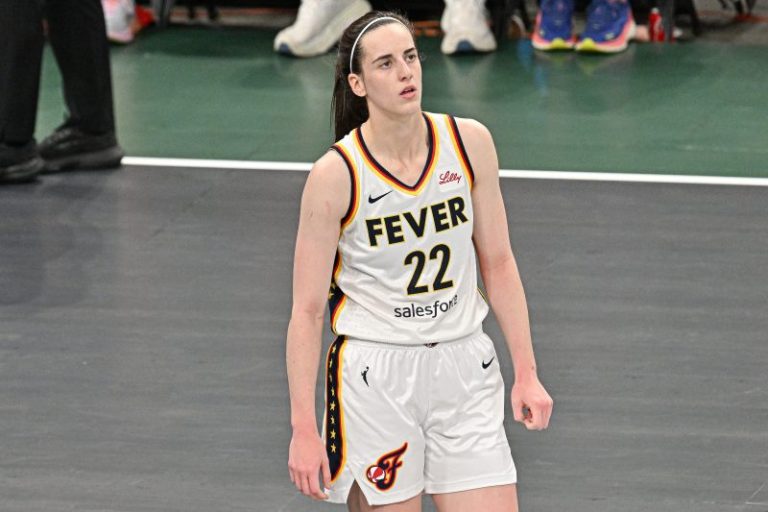No Caitlin Clark 3-pointers? No problem for the Indiana Fever.
The Fever star didn’t hit a single 3-pointer for the first time in her WNBA career, but her team held on to beat the Atlanta Dream 81-76 on Thursday.
It was a frustrating 3-point shooting night for Indiana overall, but especially for Clark. She was mostly quiet on the night as she dealt with foul trouble, finishing with 11 points, six assists and four rebounds. From 3-point land, she went 0-for-5.
It’s the first time she’s played a game without a made 3 since Jan. 13, 2022, when she was a sophomore at Iowa.
Despite the tough night for Clark, Indiana dominated near the bucket. Natasha Howard had a game-high 26 points on 12-for-17 shooting as the Fever outscored Atlanta 46-20 in the paint. The Dream did most of their damage from behind the arc with 10 made 3-pointers. Rhyne Howard led Atlanta with 24 points and three makes from behind the arc.
It was back-and-forth for much of the game and Atlanta led with less than three minutes to go, but Kelsey Mitchell made her first 3-pointer of the night when it mattered most, putting the Fever ahead for good with 85 seconds left. Indiana closed the game on a 10-1 run.
Indiana gets revenge after Atlanta defeated the Fever at Gainbridge Fieldhouse on Tuesday and moves to 2-1 on the season.
Caitlin Clark, Fever vs. Dream highlights
Caitlin Clark stats tonight
- Points: 11
- Assists: 6
- Rebounds: 4
- Steals: 1
- Blocks: 0
- Turnovers: 4
- Fouls: 5
- Shooting: 4-for-11
- 3-point shooting: 0-for-5
- Free throws: 3-for-5
Fever closing in on victory
Indiana is on its way to hanging on, leading 80-76 with five seconds left. Caitlin Clark found Aliyah Boston for a critical layup to extend the lead, and Atlanta couldn’t respond.
Indiana leads Atlanta with one minute left
Kelsey Mitchell hits her first 3-pointer of the game to give Indiana a 76-75 lead. Caitlin Clark then hits one of two free throw attempts to make it a two-point ballgame in the final minute.
Caitlin Clark in foul trouble
It’s been a frustrating night for Clark, and it could end early. She picked up her fifth foul with 2:32 left in the game and one more will result in her fouling out. Atlanta has a 75-71 lead.
Brittney Griner fouls out
It’s another early exit for Brittney Griner. She fouls out with 3:38 left in the contest, the second straight game she has fouled out against Indiana. It wasn’t a quiet night for Griner as she was mostly in foul trouble with five points, seven rebounds and one block.
Atlanta leads 71-68.
End of 3rd: Fever 61, Dream 58
This game looks like it will go down to the wire with the Fever up by three points with 10 minutes left.
Atlanta had a run sparked by Te-Hina Paopao to tie it midway through the third quarter before Indiana gained some control back. Despite the lead, it’s been a relatively quiet night for Clark as she has just six points, five assists and one rebound. However, it’s been the Natasha Howard show for Indiana. She’s been efficient on the floor with a game-high 21 points on 10-for-14 shooting as the Fever have dominated near the bucket.
Despite not shooting the ball as well as Indiana, Atlanta has relied on the 3-point shot to keep the game close with nine deep shots made.
Fever, Dream tied
An 8-0 run by Atlanta has the score knotted up at 46-all with 5:31 left in the third quarter. The run has been sparked by rookie Te-Hina Paopao, who drilled back-to-back 3-pointers and has 11 points on the night. She’s one of three Atlanta players in double-figures alongside Rhyne Howard and Brionna Jones.
End of 2Q: Fever 37, Dream 34
A furious second quarter by the Fever has given Indiana a slight lead at halftime. After trailing by as much as eight points in the first quarter, Indiana got out to an 11-0 run to start the second frame and outscored Atlanta 24-16 in the quarter. It was primarily Kelsey Mitchell that got the Fever going with all nine of her points so far coming in the second quarter.
Rhyne Howard and Brionna Jones have been clicking for Atlanta as they account for 24 of the Dream’s points. Each player has also made two 3-pointers.
It was a mostly quiet effort from Clark in the first half with just four points, and she already has three fouls.
Sophie Cunningham has made a positive impact in her first game with Indiana as she’s dealt with an ankle injury. She was a +12 in the first half with five points, five rebounds and three assists.
Fever start 2Q on run
Indiana is starting to click with a 11-0 run to start the second quarter to take a 24-18 lead.
End of 1Q: Dream 18, Fever 13
Atlanta used a hot start to get an early lead on Indiana and lead by five after the first quarter.
The Dream started the game on a 12-4 run before Indiana’s offense found some rhythm to get back in the game. The combination of Rhyne Howard and Brionna Jones have done most of the damage for Atlanta with seven points each.
Clark was mostly quiet to start with just two points in the first 10 minutes.
Caitlin Clark, Rhyne Howard shove each other
Things have gotten chippy early with Clark and Howard exchanging words after they shoved each other.
Toward the end of the first quarter, Howard was guarding Clark as she brought the ball up court. A foul was called on Howard and immediately afterward, the two shoulder checked the other. Words were exchanged and the two were separated. No excessive foul was called on either player.
Atlanta takes early lead
The Dream have gotten out to a solid start in their first home game of the season. Atlanta leads 12-4 with 4:33 left in the first quarter.
Indiana has struggled shooting and taking care of the ball. It’s just 2-for-8 from the field with four turnovers. Clark scored the first bucket of the night for the Fever and has two points.
Indiana Fever starting lineup
- Caitlin Clark, guard
- Kelsey Mitchell, guard
- DeWanna Bonner, forward
- Natasha Howard, forward
- Aliyah Boston, forward
Atlanta Dream starting lineup
- Te-Hina Paopao, guard
- Allisha Gray, guard
- Rhyne Howard, guard
- Brionna Jones, forward
- Brittney Griner, center
What time is Fever vs. Dream?
The Indiana Fever vs. Atlanta Dream game will tip off at 7:30 p.m. ET on Thursday, May 22 at State Farm Arena in Atlanta.
How to watch Fever vs. Dream game: TV, stream
- Time: 7:30 p.m. ET
- Location: State Farm Arena in Atlanta
- TV (local): MeTV Indianapolis | PeachtreeTV
- Stream: Prime Video
Fever vs. Dream odds
Odds via BetMGM
- Spread: Fever (-4.5)
- Moneyline: Fever (-190); Dream (+154)
- Over/under: 173.5










